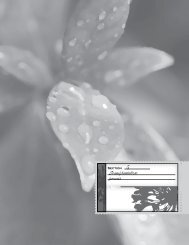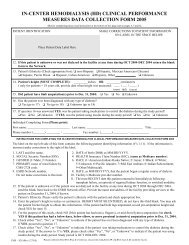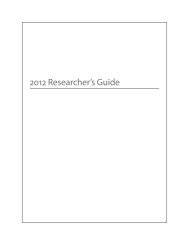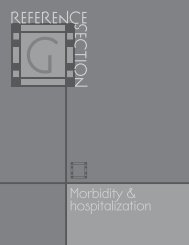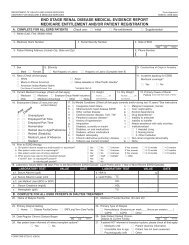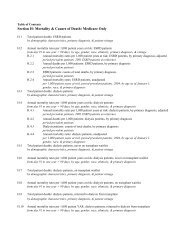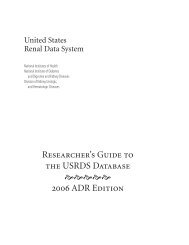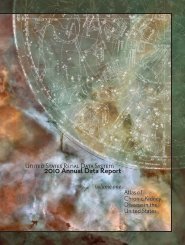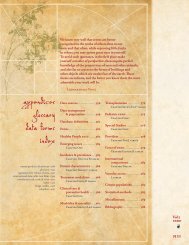4. Patient Characteristics from CMS Medical Evidence Form
4. Patient Characteristics from CMS Medical Evidence Form
4. Patient Characteristics from CMS Medical Evidence Form
You also want an ePaper? Increase the reach of your titles
YUMPU automatically turns print PDFs into web optimized ePapers that Google loves.
<strong>Patient</strong> <strong>Characteristics</strong> <strong>from</strong> HCFA <strong>Medical</strong> <strong>Evidence</strong> <strong>Form</strong><br />
USRDS 1999 Annual Data Report<br />
40<br />
30<br />
Distribution of Facilities by Percent of <strong>Patient</strong>s<br />
with Zero Comorbidities Reported, 1995-97*<br />
Facilities (%)<br />
27.2<br />
33.0<br />
N = 3,250 Facilities **<br />
20<br />
18.7<br />
10<br />
0<br />
1.9<br />
5.7<br />
0 0+ to<br />
10%<br />
10+ to<br />
20%<br />
20+ to<br />
30%<br />
30+ to<br />
40%<br />
7.3<br />
40+ to<br />
50%<br />
2.8<br />
50+ to<br />
60%<br />
Figure IV-13<br />
1.5<br />
60+ to<br />
70%<br />
0.4 0.7 0.6 0.2<br />
70+ to<br />
80%<br />
80+ to<br />
90%<br />
90+ to<br />
< 100%<br />
Percent of <strong>Patient</strong>s with Zero Comorbidities Reported<br />
*Reported on HCFA <strong>Medical</strong> <strong>Evidence</strong> <strong>Form</strong><br />
IV -13<br />
**Excludes facilities with < 5 new patients in 3 years USRDS 1999<br />
100%<br />
Distribution of facilities by percent of patients with zero comorbidities as reported on the HCFA <strong>Medical</strong><br />
<strong>Evidence</strong> <strong>Form</strong>, 1995-97. Facilities with less than 5 new patients in 1995-97 are excluded. Source: Special<br />
Analysis.<br />
The timing of dialysis initiation among patients<br />
with advanced renal disease is the subject of much<br />
controversy. While there are the protagonists of the<br />
“early start” hypothesis (Mehrotra), available data are<br />
suggestive but not conclusive that earlier initiation of<br />
dialysis confers a survival advantage. On the<br />
<strong>Medical</strong> <strong>Evidence</strong> <strong>Form</strong>, all new ESRD patients<br />
initiating dialysis have a serum creatinine prior to<br />
first dialysis recorded in addition to dry weight and<br />
height. From these data, an individual’s residual<br />
renal function may be estimated.<br />
Figure IV-14 allows the comparison of the mean<br />
serum creatinine to the estimated glomerular<br />
filtration rate (GFR) by the Modification of Diet in<br />
Serum Creatinine and GFR<br />
for New ESRD <strong>Patient</strong>s by Age Group, 1995-97*<br />
15<br />
Average Serum Creatinine (mg/dl)<br />
Average GFR (ml/min)**<br />
15<br />
10<br />
10.8<br />
8.7<br />
7.5<br />
7.0<br />
6.6<br />
7.1<br />
7.7 8.0<br />
10<br />
5<br />
5<br />
0<br />
20-44 45-64 65-74 75+ 20-44 45-64 65-74 75+<br />
Age<br />
Age<br />
*Reported on HCFA <strong>Medical</strong> <strong>Evidence</strong> <strong>Form</strong><br />
**MDRD <strong>Form</strong>ula<br />
Figure IV-14<br />
0<br />
IV -14<br />
USRDS 1999<br />
Average serum creatinine and GFR for new ESRD patients as reported on the HCFA <strong>Medical</strong> <strong>Evidence</strong><br />
<strong>Form</strong> by age on first service date, 1995-97. Glomerular filtration rate (GFR) is computed using MDRD<br />
formula. Source: Reference Table L.23.<br />
68



